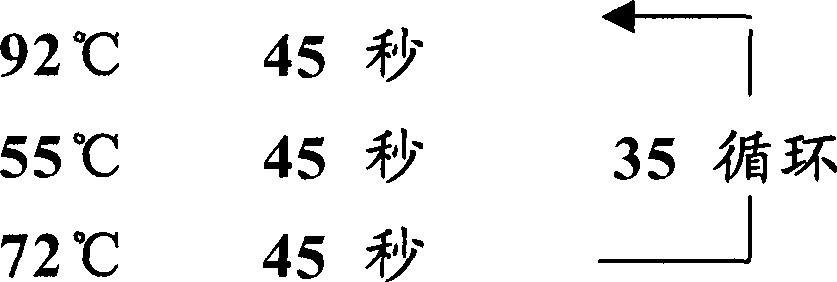Infectious etiologic agent detection probe and probe set, carreir, and genetic screening method
A technology for pathogen detection and probe sets, applied in microorganism-based methods, biochemical equipment and methods, and resistance to vector-borne diseases, etc., can solve problems such as difficulty in designing primers for PCR amplification reactions.
- Summary
- Abstract
- Description
- Claims
- Application Information
AI Technical Summary
Problems solved by technology
Method used
Image
Examples
Embodiment 1
[0036] Example 1 Detection of microorganisms using 1-step PCR method
[0037] [1. Preparation of probe DNA]
[0038] Tables 1 to 10 show the nucleic acid sequences designed as probes for the detection of the above-mentioned 10 kinds of pathogens. Specifically, the base sequences of the probes shown below were selected from genomes encoding 16s rRNA of various bacteria. These probe nucleotide sequence sets designed are very specific for this bacterium, and there is no deviation in the nucleotide sequence of each probe, and it is expected that sufficient hybridization sensitivity can be obtained. In addition, it is not necessarily limited to being completely identical to each probe base sequence shown in Tables 1 to 10. Probe base sequences having a length of about 20 to 30 bases including each probe base sequence are also included in the probe base sequences shown in each table. Complementary sequences (complementary strands) to the nucleotide sequences shown in the above ta...
Embodiment 2
[0128] Example 2 Detecting microorganisms with 2-step PCR method
[0129] In the same manner as in Example 1, probe DNA, PCR primers for sample amplification, genomic DNA of each pathogen, and DNA microarray were prepared, and the following experiments were performed.
[0130] [1. Specimen amplification and labeling (PCR amplification & fluorescent labeling)]
[0131] Amplification (Ist PCR) and labeling (2nd PCR) reactions of microbial genes used as samples are shown below.
[0132] [2. Composition of amplification reaction solution: 1st PCR]
[0133] Premixed PCR Reagent (TAKARA ExTaq) 25μl
[0134] Template genomic DNA 2μl (10ng)
[0135] Forward primer mix 2μl (20pmol / each tube)
[0136] Reverse primer mix 2μl (20pmol / each tube)
[0137] Water 19μl
[0138] Total 50μl
[0139] The reaction solution with the above composition was subjected to the amplification reaction using a commercially available thermal cycler according to the following protocol.
[0140] 95°C 1...
Embodiment 3
[0179] Example 3 Detecting microorganisms with 2-step PCR method
[0180] In the same manner as in Examples 1 and 2, probe DNA, PCR primers for sample amplification, genomic DNA of each pathogen, and DNA microarray were prepared, and the following experiments were performed.
[0181] [1. Amplification and labeling of the sample (using fluorescently labeled PCR primers)]
[0182] Amplification (Ist PCR) and labeling (2nd PCR) reactions of microbial genes used as samples are shown below.
[0183] [2. Composition of amplification reaction solution: 1st PCR]
[0184] AmpliTaq Gold LD (50U / μl) 0.5μl
[0185] template genomic DNA variable
[0186] dNTP mis(2.5mM / each) 4.0μl
[0187] ×10 PCR buffer 5.0μl
[0188] 25mM MgCl 2 7.0μl
[0189] Forward primer mix (10μM / each) 0.25μl
[0190] Reverse primer mix (10μM / each) 0.25μl
[0191] water variable
[0192] Total 50μl
[0193] The reaction solution with the above composition was subjected to an amplificat...
PUM
 Login to View More
Login to View More Abstract
Description
Claims
Application Information
 Login to View More
Login to View More - R&D
- Intellectual Property
- Life Sciences
- Materials
- Tech Scout
- Unparalleled Data Quality
- Higher Quality Content
- 60% Fewer Hallucinations
Browse by: Latest US Patents, China's latest patents, Technical Efficacy Thesaurus, Application Domain, Technology Topic, Popular Technical Reports.
© 2025 PatSnap. All rights reserved.Legal|Privacy policy|Modern Slavery Act Transparency Statement|Sitemap|About US| Contact US: help@patsnap.com



